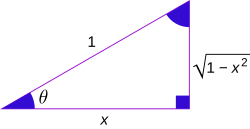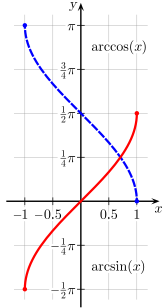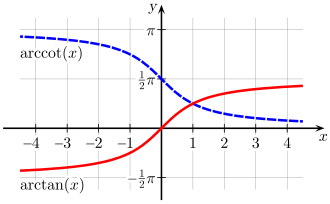The principal inverses are listed in the following table.
Domains
If x is allowed to be a complex number, then the range of y applies only to its real part.
The table below displays names and domains of the inverse trigonometric functions along with the range of their usual principal values in radians.
Name
| Symbol | | Domain | | Image/Range | Inverse
function | | Domain | | Image of
principal values |
|---|
| sine |  |  |  |  |  |  |  |  |  |  |
| cosine |  |  |  |  |  |  |  |  |  |  |
| tangent |  |  |  |  |  |  |  |  |  |  |
| cotangent |  |  |  |  |  |  |  |  |  |  |
| secant |  |  |  |  |  |  |  |  |  |  |
| cosecant |  |  |  |  |  |  |  |  |  |  |
The symbol  denotes the set of all real numbers and
denotes the set of all real numbers and  denotes the set of all integers. The set of all integer multiples of
denotes the set of all integers. The set of all integer multiples of  is denoted by
is denoted by

The symbol  denotes set subtraction so that, for instance,
denotes set subtraction so that, for instance,  is the set of points in
is the set of points in  (that is, real numbers) that are not in the interval
(that is, real numbers) that are not in the interval 
The Minkowski sum notation  and
and  that is used above to concisely write the domains of
that is used above to concisely write the domains of  is now explained.
is now explained.
Domain of cotangent  and cosecant
and cosecant  : The domains of
: The domains of  and
and  are the same. They are the set of all angles
are the same. They are the set of all angles  at which
at which  i.e. all real numbers that are not of the form
i.e. all real numbers that are not of the form  for some integer
for some integer 

Domain of tangent  and secant
and secant  : The domains of
: The domains of  and
and  are the same. They are the set of all angles
are the same. They are the set of all angles  at which
at which 
























































































































































































































































































































































































































